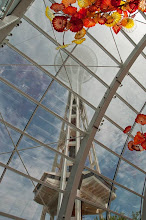
My husband and I were fascinated by this glass when we were buying at auctions and estate sales. You have to be extremely careful when cleaning as the paint is not fired onto the glass. We don't know what factory produced our pieces, but they are unique. Wikipedia has this to say about Goofus Glass:
Goofus glass is basically pressed glass which was cold (un-fired) paint decorated in the early 20th century in America by several prominent glass factories. It was made in considerable quantities and sold originally for very little. It was given as premiums for buying things, awarded as prizes at Fairs, and actually was the first "carnival glass" preceding the iridized product we refer to as carnival glass today. Articles included but weren't limited to plates, bowls, vases, oil lamps, dresser sets, salt and pepper shakers and candle holders. The most common colors used were gold, red, and green with gold usually being the predominant color. Indiana Glass Company in Dunkirk, Indiana was possibly the most prolific producer of this inexpensive decorated ware. It was not known by that name initially, but gained the name possibly because the painted decoration wasn't very durable and people felt perhaps that it was "goofy" or that someone had tried to "goof - us".
More attractive pieces preceding Indiana's offerings existed as turned out by the Dugan Diamond Company and H. Northwood. These consisted of lines of pressed glass known as "Intaglio" and paint decorated opalescent glass. These pieces are the most highly valued items collectors seek today. There are also decorated milk glass objects to be found, a number of which were produced by the Westmorland Specialty Company. While some collectors incorrectly refer to paint decorated opalescent items and milk glass items as "Goofus glass", it is more correct to say that they are "Goofus decorated" opalescent and milk glass, thus the term "Goofus" has come to refer more to the use of un-fired enamel decoration to a piece of pressed glass than to the glass itself.
It is extremely difficult to pinpoint the exact time of start and finish of this exclusively American glass making phenomena (different Mfg.s, different times). It has been thought to have started around 1900 perhaps and surely was all but effectively ended by 1930, although many feel it really ended for all practical purposes as a staple item of the glass factories as soon as the process for iridized glass was discovered and started being produced. There was so much of it made that it continued to turn up for years and is still to be found on EBay. There is no contemporary reference book in print and but one web site which provides the most information available on it.
Here is another photo of one in our collection.






No comments:
Post a Comment